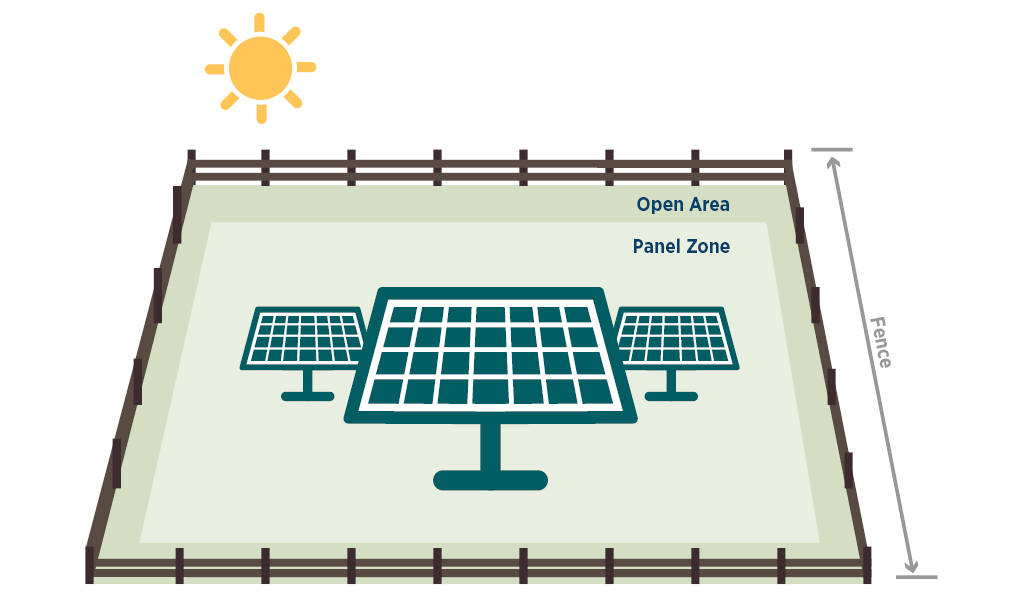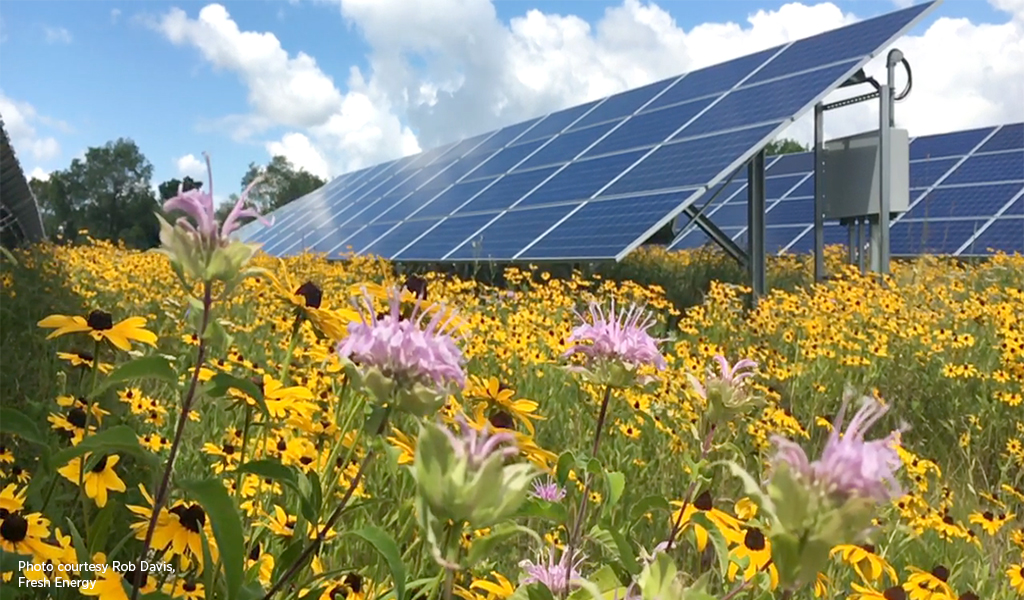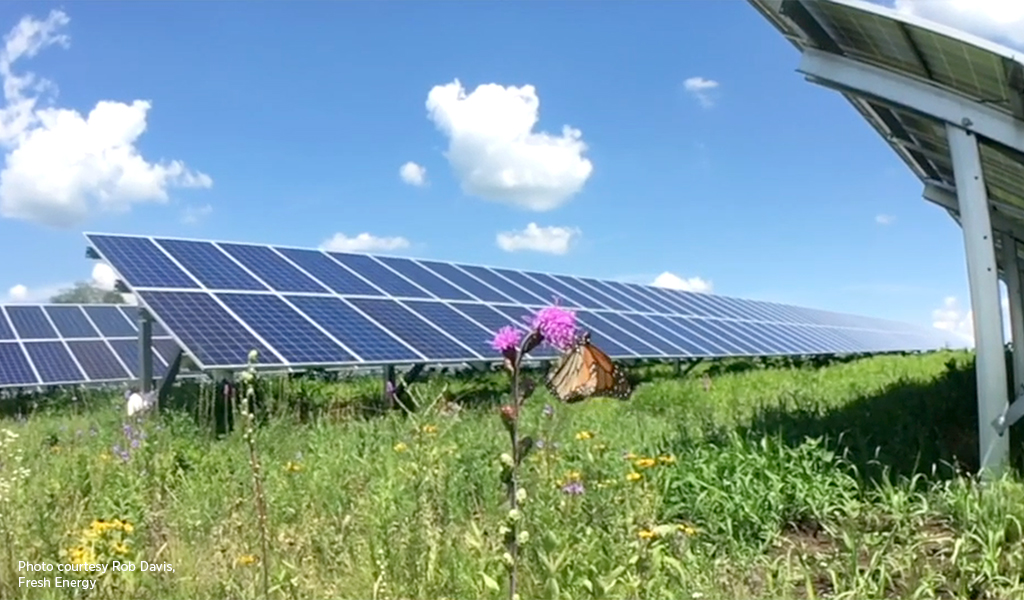Forward-thinking insights focused on a more sustainable tomorrow.
Catalyst for Change: How Pollinator-Smart Solar Facilities Are Taking Sustainability to the Next Level
Solar facilities or “solar farms” associated with solar energy generation have increasingly become a greater part of our country’s energy portfolio and landscape throughout the past decade. And, with recent technological advances made in the fields of battery storage, this form of clean, safe, and renewable energy generation is projected to continue to increase over the foreseeable future across the United States. Finding responsible solutions to our energy needs has become a national and global priority, and today’s energy conservation is all about variety and innovation, including encouraging sustainable design in the built environment that positively impacts overall well-being through increased availability of healthy food options.
Sustaining Pollinators and Our Future
Pollinator-smart solar design, which incorporates pollinator-attracting native plants into available space around ground-mounted solar sites, is an emerging approach to meeting energy needs, while also promoting health and well-being. The pollinator population, including bees, birds, bats, butterflies, and several other organisms, plays a crucial role in crop pollination, enabling crops to grow and, ultimately, be harvested for the end user—humans.
Pollinator population is experiencing a global decline that affects not only the amount of crop to be harvested, but the quality of the crop itself. This current decline is the result of a variety of issues, including:
- Parasites and disease
- Indiscriminate and inappropriate use of chemicals
- Introduction of non-native or invasive species
- Habitat fragmentation due to changing land use
Expanding the use of solar facilities by taking better advantage of the vegetation area immediately under and around the panels (panel zone) and the area outside the panel zone (open area) can help improve upon at least two of these issues rather rapidly—invasive species and habitat loss/fragmentation—and is an opportunity for sustainable change.
Vegetation Zones

Reimagining Solar Facility Land Use
While pollinator species are decreasing, the solar industry is growing at lightning speeds throughout the country. Five of the top 10 solar states (based on installed mega-watts in 2018) are located along the east coast, including North Carolina (#2), New Jersey (#5), Massachusetts (#6), Georgia (#9) and Florida (#10). This growth can be attributed to several factors, including advancements in innovative technologies, reduction in manufacturing and installation costs, and federal incentives for solar implementation. Just in the Commonwealth of Virginia alone, there are plans to have an additional 5,000+/- megawatts—or approximately 40,000 to 50,000 acres of land—slated for solar development over the coming years.
Recognizing the interrelationships between organisms and their environment is a critical component to successfully designing a suitable pollinator-smart facility. Even more critical is the selection of all native species (preferably local genetic stock) based on specific criteria, such as desired height, soil and light requirements, flowering periods, and moisture requirements. While there is no one-size-fits-all solution, planting with a high diversity of native species has been shown to be one of the most effective approaches to combating the incursion of invasive species. A diverse native planting palette also increases the likelihood of attracting a variety of pollinators (involving flowering throughout multiple seasons), which increases the chances for improving crops, providing accessibility to healthy food options, and sustaining a healthy lifestyle.
A native plant materials industry is paramount to meet the anticipated growth projected for the solar industry if pollinator-smart habitats are to be planted on solar facilities. Currently, most states do not have an established scale of native plant material with local genetic stock sufficient to meet the demand of this new best-management practice. However, the Commonwealth of Virginia plans to work with a variety of stakeholders (i.e., various state, federal, and local governmental agencies; non-profits; advocacy groups; law firms; commercial plant vendors; and engineering, procurement, and construction (EPC) contractors) to develop a business plan suitable to launch a native plant materials industry. This is an excellent opportunity to implement sound stewardship practices that will not only benefit wildlife and humanity for years to come, but also foster growth in Virginia’s energy sector.

Building Smart Elevates Sustainability
Beyond providing optimal habitat conditions for pollinator species, incorporating pollinator-smart landscapes offers many other benefits—not just for solar facilities, but for a wide range of landscape settings and land uses, such as in linear corridors and large tracts of both developed and undeveloped lands. Opportunities exist for a more productive use of habitats found in highway, transit, and rail rights-of-way, as well as along electric and gas transmission corridors and large land holdings. Implementing pollinator-smart habitats can play a key part in promoting any of these transportation, energy, and land development infrastructure improvements projects while having additional benefits, such as:
- More pleasing aesthetics
- Deeper root zones for improved water quality
- Increased soil stability
- Improved flora and fauna species richness and biodiversity
- Reduced Operation and Maintenance (O&M) costs over the project’s lifecycle—along with reducing greenhouse gas emissions through mowing
Pollinator-smart habitats can also benefit people and communities through increased employment opportunities, and programs like potential native seed banking—developing large-scale seed nurseries that can be used to support this pollinator-smart growing market, as well as supporting other existing pollinator programs throughout the world. Pollinator-smart solar facilities can help encourage and promote farm-to-table concepts and community garden programs, as well as provide educational opportunities for living laboratories, giving current and future generations of engineers and scientists optimum research scenarios with direct applications to sustainability.

Renewable energy sources, including solar power, provide a variety of benefits, including improved energy efficiency and reduced environmental impacts. Pollinator-smart solar facilities can help foster sustainability by not only meeting energy needs, but also through economic development, community enhancement, and healthy food production. VHB is advancing its commitment to sustainability within our energy practice by providing our clients with innovative solutions to renewable energy.
As the demand for solar power increases, VHB supports the design and development of solar projects to meet diverse needs. We partner with our clients to achieve a pollinator-smart context for their projects, aimed at taking sustainability to the next level, including:
- Developing an innovative and sustainable program to establish pollinator-smart habitats on solar facilities throughout Virginia and to meet anticipated projected growth for the Commonwealth’s solar industry with the Virginia Department of Environmental Quality and Virginia Department of Conservation & Recreation—the first project of its kind in the United States.
- Conducted a pilot study to evaluate potential effects of solar energy generation projects on Vermont’s wetlands, including native vegetation communities, which has been instrumental in helping to inform Renewable Energy Vermont’s solar site pollinator program. This program culminated in development of the State’s first Solar Site Pollinator Habitat Planning & Assessment Form, which provides a score card for verifying when beneficial habitats have been created.
- Working with EnterSolar—a leading solar provider to the commercial market—on a three-megawatt solar project located on Staten Island, providing technical assistance with development of a Pollinator-Smart Planting Plan on approximately 20-acres of land to maximize benefits to pollinators and promote sustainability.
- Partnering with various utilities and energy providers throughout the country on implementing pollinator-smart practices in support of energy generation and transmission/distribution projects, with an emphasis on reducing overall O&M costs throughout the project lifecycle.
How VHB Can Help
VHB’s broad knowledge of the regulatory environment and latest energy policies and trends provides our public and private sector clients with comprehensive, integrated solutions that help develop energy sources for the future while minimizing impacts to the environment. Contact Kris Dramby to learn more about our integrated service approach to developing forward-thinking, implementable plans for pollinator-smart solar energy practices.



